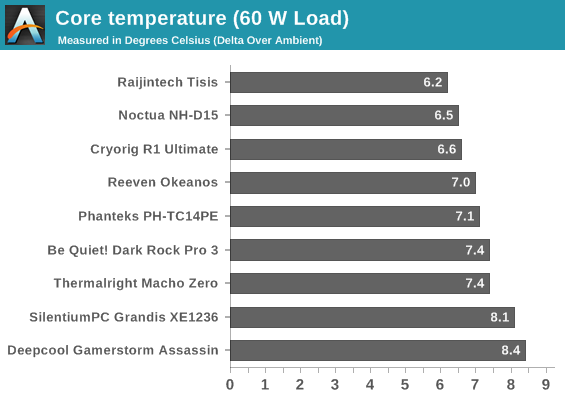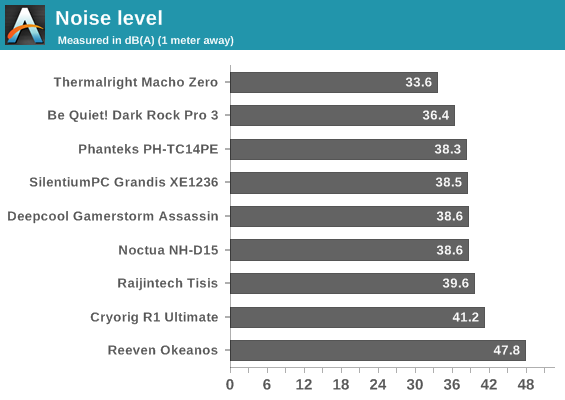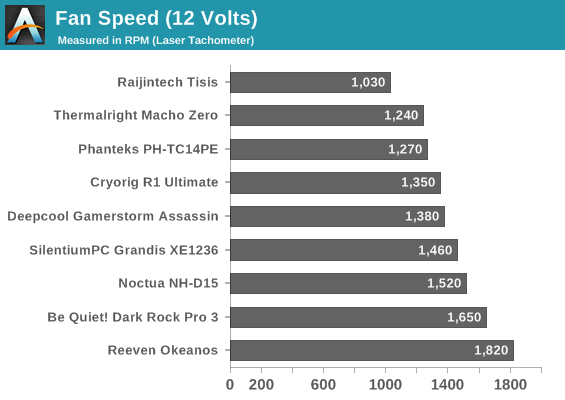Top Tier CPU Air Coolers Q3 2015: 9-Way Roundup Review
by E. Fylladitakis on July 6, 2015 8:00 AM ESTTesting results, maximum fan speed (12 Volts)


| Core Temperature, Constant Thermal Load |
|
|


*Note: When the cooler has two different fans, the fan speed of the faster fan is recorded.
We should start by noticing that one should be extremely careful when reading the performance charts. Even though some of the coolers are of similar design or size, their performance differs greatly. Similarly, coolers with similar thermal performance may have great differences in size, acoustics and or price.
Without a doubt, the grandest example of this warning is the Okeanos. Reeven's offering outpaces nearly every other cooler, comparing directly with Noctua's and Cryorig's finest, when tested at our maximum load and has the best average absolute thermal resistance. However, this is not due to excelling technology or design. On the contrary, the Okeanos is simpler and smaller than most of the coolers in this review. This achievement is simple brute force through high speed fans, which places the Okeanos far behind any other offering on acoustics.
Not unexpectedly, the thermal performance charts are being led by the Noctua NH-D15, the Cryorig R1 Ultimate and the Phanteks TC14PE. These are the best coolers of the most renowned manufacturers, so one would expect interative designs over time to yield benefits. The performance differences between these three offerings, thermal and acoustic alike, are very small. Raijintech's Tisis is the surprise of this review, with similar thermal and acoustics performance to that of the best coolers. The Tisis also has the best low load performance, where the charts shift greatly.
The Dark Rock Pro 3 from Be Quiet! offers lower noise levels but falls a little behind on thermal performance. Not the same can be said about Deepcool's offering, the Assassin, which does not match the thermal performance of the best coolers but is neither quieter nor notably cheaper. The performance gap is rather small but the Assassin is at a disadvantage. The Grandis falls even further behind in terms of thermal performance while the noise levels are similar, but SilentiumPC designed it to be more budget-friendly than other offerings, not to compete with the elite on terms of raw performance. Thermalright's Macho Zero is also an inconsistency in this review, as this cooler is not meant to provide maximum thermal performance and hits the bottom of our absolute thermal resistance charts. On the other hand, the Macho Zero paired with the TY147A is by far the quietest cooler in this review, being whisper-quiet even while the fan is spinning at maximum speed.










135 Comments
View All Comments
Peichen - Monday, July 6, 2015 - link
I expect many R9 Fury X users are shopping for large air-cooler now as they have to give up their AIO CPU-cooler to Fury.BTW, I really wish you added a Hyper 212X as reference.
meacupla - Monday, July 6, 2015 - link
You could just buy a case like the Fractal Design Define S, which could fit two separate 120mm CLLC in the front, allowing both to get fresh air.Flunk - Monday, July 6, 2015 - link
I'm a bit disappointed that you didn't comment on the install process on any of the heatsinks. I recently bought a Dark Rock Pro 3 and while I love how quiet it is and the temps are actually lower than the Corsair Hydro H80 it replaced, the install process requires you to screw the heatsink in from the back of the motherboard. That and the size of the supplied backplate made the heatsink install more difficult that is really necessary.If you buy a Dark Rock 3 Pro I recommend removing the motherboard from the case entirely and installing it by flipping the heatsink upside down and balancing the motherboard on top of it in the correct position. This makes it fairly easy to screw in. But if you are using a normal thermal paste you might need to put it on the heatsink instead of the CPU heatspreader. I use IC Diamond and that stuff is so thick that it just stuck there upside down for long enough to finish mounting the thing.
meacupla - Monday, July 6, 2015 - link
Yeah, this is actually quite important. Noctua's mounting brackets are, by far, one of the easiest to work with.'nar - Tuesday, July 7, 2015 - link
I never gave it much thought. Installation is such a small concern to me, maybe I do this more than most, price and performance are preferable. That said, I still think Noctua's mounting can be improved, it seems unnecessarily complicated to me. First off, you really do need to replace the plastic bracket, there's no way around that. But secondly, why include a 140mm screw driver? Why not make the screws 140mm taller? Then you can just use a common screw driver, even a stubby or a pocket knife. And make them captive so they do not fall out and you do not need to line them up. These will certainly add to the cost due to extra engineering time and unique screws.Beany2013 - Wednesday, July 8, 2015 - link
Because the 140mm screwdriver:A: Is cheaper than re-engineering the entire product
B: long screws are *very* easy to cross-thread due to the extra sideways torque you can apply when inserting them.
I *do* like the Noctua setup system. It's strong, comprehensive, and lets be honest, you only do it once. I'm pretty sure that any gotchas with installation were caught in the descriptions of each cooler, too.
der - Monday, July 6, 2015 - link
WOOOO!golemB - Monday, July 6, 2015 - link
For the Macho Zero especially, I'd want to see the tests conducted (additionally) in a vertical motherboard orientation (as you'd have in most tower cases), since convection may have an effect on performance. It may also reveal differences in fan noise due to bearings rubbing more or less on different surfaces.'nar - Tuesday, July 7, 2015 - link
Not likely. Convection is slow. Any fans will blow away convection currents. Besides, orientation is strictly a "case by case" basis and beyond the scope of an empirical HSF comparison.Fan noise due to orientation may be good to check for though. I doubt it will be any different, if it is, the aberration should be noted.
flashbacck - Monday, July 6, 2015 - link
wow, cpu cooler roundup! It seems so rare to see these nowadays.